Properties of Food From a TCM Perspective
According to traditional Chinese medicine (TCM), foods are just as herbs that can be selected and prepared appropriately to tonify, cleanse and regulate the body.
1. The five energies of foods
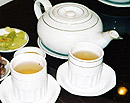
The energies of foods refer to their capacity to generate sensations - either hot or cold - in the human body. The five kinds of energy are cold, hot, warm, cool and neutral, and this refers not to the state of the food but its effect on our bodies. For example, tea has a cool energy, it means that when we drink hot tea, it generates cool energy and it is therefore considered a cool beverage. Shortly after you have drunk hot tea, the heat begins to fade quickly and it begins to generate cool energy internally, allowing your body to cool off.
Here are some food samples with different energies.
| Energy generated | Food samples | |
| Yin | Cold | Bamboo shoot, chrysanthemum, bitter gourd, lotus root, water chestnut, root of kudzu vine, wild rice stem, angled luffa, sugar cane, tomato, watermelon, banana, pomelo, grapefruit, persimmon, mulberry, star fruit, preserved jellyfish, seaweed, kelp, cuttlefish, crabs, sea clams, snails, pig's bone marrow, sprouts, water spinach, watercress, lettuces, arrowhead, soybean milk, salt and soya sauce. |
| Yin | Cool | Millet, barley, wheat, buckwheat, coix seed, eggplant, cucumber, wax gourd, loofah, Chinese radish, lettuce root, celery, peppermint, broccoli, cauliflower, leaf mustard, spinach, Peking cabbage, Chinese cabbage, amaranth, Indian lettuce, lily bulb, pea, mung bean, pears, muskmelon, apple, pineapple, coconut, strawberry, orange, tangerine, loquat fruit, mango, papaya, water caltrop, tea leaf, bean curb, mushrooms, lily flower, duck egg, egg white, pig skin, rabbit meat, conch, frogs, sesame oil, cream, yogurt and cheese. |
| Balanced yin and yang | Neutral | Round-grained rice, corn, taro, sweet potato, potato, turnips, carrot, cabbage, radish leaf, beetroot, fuzzy melon, soybeans, adzuki beans, peanut, cashew nut, pistachio nut, lotus seed, black sesame, sunflower seed, plums, fig, grapes, lemon, olives, white fungus, black fungus, shiitake mushroom, sea shrimps, loach, pork, duck, goose, oyster, beef, quail, sea eels, egg yolk, quail egg, royal jelly honey, milk, rock sugar and sugar. |
| Yang | Warm | Coriander, Chinese chives, onion, leeks, green onion, asparagus, sweet peppers, sword bean, spearmint, Garland chrysanthemum, pomegranate, apricot, peach, cherry, litchi, longan fruit, raspberry, chestnut, pumpkin, glutinous rice, dates, walnut, pine nut, mussels, fresh water eels, sea cucumber, carps, abalone, hairtail, lobster, fresh water shrimps, chicken, mutton, sparrow, venison, pig's liver, ham, goat milk, goose egg, sparrow egg, maltose, brown sugar, cumin, clove, fennel, garlic, ginger (fresh), dill seed, nutmeg, rosemary, star anise, Sichuan peppercorn, sweet basil, sword bean, tobacco, coffee, vinegar, wine, vegetable oil, rose bud, osmanthus flowers and jasmine. |
| Yang | Hot | Black pepper, cinnamon, ginger(dried), chili pepper, and mustard seed. |
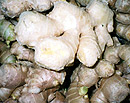
It is important to know about the energies of food because different energies act upon the human body in different ways and affect our state of health. If a person suffers from cold rheumatism and the pain is particularly severe on cold winter day, eating foods with a warm or hot energy shall relieve the pain considerably. Or if a person suffers from skin eruptions that worsen when exposed to heat, it is beneficial to eat foods with a cold or cool energy to relieve the symptoms.
To seek a balance in diet, we can define food as predominantly yin or yang. If you eat predominantly yin foods, your body will be capable of producing more yin energy-darker, slower-moving and colder. In contrast, eating predominantly yang foods will produce more yang energy - faster, hotter and much more energetic. It's helpful to remember certain rules to determine the type of energy a food produces:
- If it grows in the air and sunshine, it is probably yang;
- If it grows in the earth and darkness, it is probably yin;
- If it is soft, wet and cool, it is more yin;
- if it is hard, dry and spicy, it is more yang.
2. The five flavors of foods
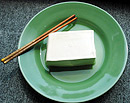
The Chinese think flavor is very important because it helps to send nutrition via the meridians to the corresponding organs. If we eat a balanced meal with many tastes, we feel satisfied and don't binge. The five flavors of food include pungent (acrid), sweet, sour, bitter, and salty. Different flavors have their respective important effects upon the internal organs:
| Flavors | Organs affected | Effects | Food samples |
| Pungent | Lung Large intestine |
Promote distributions and circulations, and stimulate appetite. | Fresh ginger, onion, leeks, green onion, Sichuan peppercorn, garlic, celery, coriander, Chinese chives, fennel, spearmint, Chinese radish, radish leaf, chili pepper, sweet peppers, turnips, taro, leaf mustard, Shanghai cabbage, cinnamon, tangerine peel, kumquat, mustard seed and wine. |
| Sweet | Stomach Spleen |
Slow down acute reactions and neutralize the toxic effects of other foods, and also lubricate and nourish the body. | Honey, dates, shiitake mushroom, taro, sweet potato, potato, pumpkin, carrot, glutinous rice, peas, soybean, rice, wheat, corn, sugar cane, peanut, milk, apple, pears, cherry, chestnut, grapes, lotus seed, longan aril, carps and abalone. |
| Sour | Liver Gall bladder |
The astringent character helps to arrest abnormal discharge of fluids and other substances from the body, such as diarrhea, emission and heavy sweating. | Lemon, tomatoes, pineapple, apple, strawberry, papaya, pears, loquat fruit, oranges, tangerines, peaches, hawthorn fruit, olives, pomegranate, plums, pomelo, mango, grapes, vinegar and royal jelly. |
| Bitter | Heart Small intestine |
Clear heat, dry dampness, stimulate appetite, and promote lowering effects like urination and bowel movements. | Bitter gourd, Indian lettuce, wine, vinegar, lotus leaf, tea leaf, turnips, apricot seed, lily bulb, gingko, plum kernel, peach kernel, seaweed, pig's liver, bergamot, arrowhead, asparagus, wild cucumber and coffee. |
| Salty | Kidney Bladder |
Dissipate accumulations, soften hardness, nourish blood, and lubricate intestines to induce bowel movements. | Amaranths, millet, barley, laver, preserved jellyfish, seaweed, kelp, sea clams, sea shrimps, oyster, crabs, sea cucumber, field snail, pork, pig's bone marrow, pig's blood, pig's organs, razor clam, dried mussel, ham, pigeon's egg, abalone, duck meat and cuttlefish. |
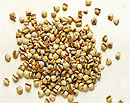 Some foods may possess two different flavors or a bland flavor which means it has little or not taste. For example, cucumbers have both sweet and bland flavors. Foods with a bland flavor usually promote urination and may be used as diuretic, coix seed and wax gourd are outstanding examples of this kind. In addition, foods with a strong scent are categorized as "aromatic", such as basil, fennel, coriander, peppermint and citrus fruits. These foods can be eaten to enliven the spleen, stimulate appetite, promote qi(vital energy) circulation, resolve dampness and turbidity, refresh the mind, open up the orifices, and detoxify.
Some foods may possess two different flavors or a bland flavor which means it has little or not taste. For example, cucumbers have both sweet and bland flavors. Foods with a bland flavor usually promote urination and may be used as diuretic, coix seed and wax gourd are outstanding examples of this kind. In addition, foods with a strong scent are categorized as "aromatic", such as basil, fennel, coriander, peppermint and citrus fruits. These foods can be eaten to enliven the spleen, stimulate appetite, promote qi(vital energy) circulation, resolve dampness and turbidity, refresh the mind, open up the orifices, and detoxify. 3. The movements of foods
Food acts on the body through specialized movements. Depending on the properties of food, food moves in different regions within the body and can drive qi (vital energy) in the same direction as well. TCM claims that disease is caused when any of the external or exogenous evils exert too much influence on our body, foods that have specialized movements can be used to counter these evils. For example, when a person suffers from mild flu (which caused by exogenous wind invasion), foods with a floating action such as green onion and fresh ginger can expel the evils out of the body.
TCM has classified the movements of foods into four aspects.
| TCM food movements | Actions | Effects | Food samples | Associated properties of food |
| Lifting | To move from lower region towards upper region | The upward movements arrest diarrhea, and hold internal organs in their proper places (to prevent them prolapse or sinking) | Wine | Warm or hot in energy, pungent or sweet in flavor. |
| Floating | To move from inside towards outside | The outward movements induce perspiration and dissipate body heat | Ginger | |
| Lowering | To move from upper region towards lower region | The downward movements relieve vomiting, hiccupping, coughing and panting | Salt | Cool or cold in energy, sour or bitter or salty in flavor. |
| Sinking | To move from outside towards inside | The inward movements slow down bowel movements and relieve abdominal distention | Vinegar |
 Lifting Lifting |
 Lowering Lowering |
 Floating Floating |
 Sinking Sinking |
In general, foods like leaves and flowers and those with light and loose qualities possess a tendency to move upwards or outwards; while roots and seeds and fruits that are heavy and hard in qualities possess a tendency to move downwards or inwards. However there are many other exceptions and some foods can move in two directions e.g. lettuce possess both downward and inward movements.
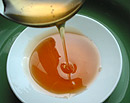 Honey is sweet in flavor and neutral in energy, it can moisten the inner body, promote bowel movements, tonify the middle burner, slow down acute reactions, detoxify and lower blood pressure.
Honey is sweet in flavor and neutral in energy, it can moisten the inner body, promote bowel movements, tonify the middle burner, slow down acute reactions, detoxify and lower blood pressure. Two other terms are also used to describe the movements of foods: glossy (sliding) and astringent. Glossy foods such as honey, banana, white fungus and milk facilitate movement by acting as a lubricant. This is why these are good for constipation and internal dryness. On the other hand, astringent foods such as guava, plum, euryale seed and lotus seed slow down movement, which is good for diarrhea and seminal emission. The movements of foods can be changed through certain methods of cooking.
References
- Chinese System of Food Cures Prevention & Remedies by Henry C. Lu.Sterling Publishing Co., Inc. 1986.
- The Tao of Food, Richard Craze and Ronifjay, 1999 Godsfield Press.
- Chinese Food: a Holistic Therapy by Tom Neuhaus, www.hopedance.org
- Medicinal Food in China by Junshi Chen, M.D. http://newcenturynutrition.com
- Cooling the Summer with Food: An Introduction to Medicinal Foods by Yanfang Wang, M.D., Ph.D. http://newcenturynutrition.com
Written By:
Dang Yi
MD PhD Professor, Beijing University of Chinese Medicine;
Visiting Professor, Middlesex University, London, UK;
Vice Director, Gourmet Food Institute of Health Care and Nutrition of Beijing, PRC.
Editors:
Raka Dewan, Integrated Chinese Medicine Holdings Ltd.
Rose Tse, Integrated Chinese Medicine Holdings Ltd.


